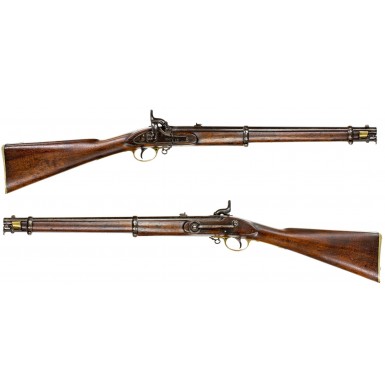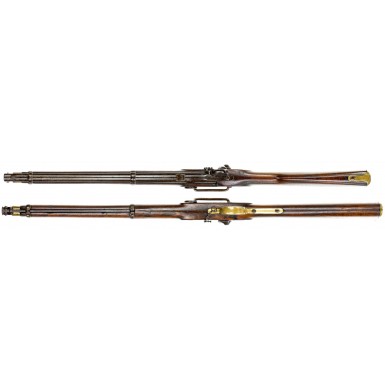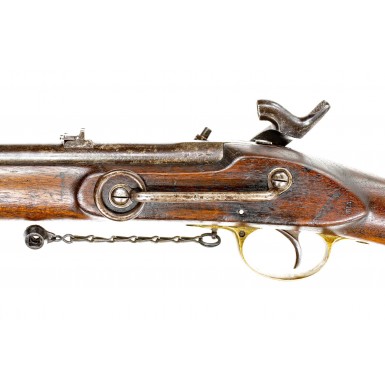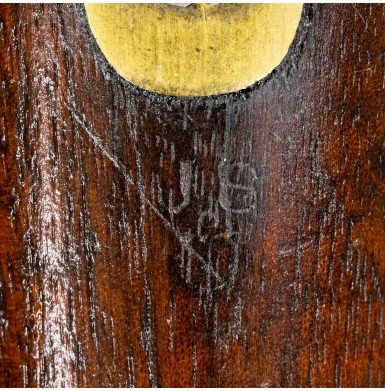Confederate JS Anchor Marked Barnett Pattern 1856 Cavalry Carbine
- Product Code: FLA-3731-SOLD
- Availability: Out Of Stock
-
$1.00
The Pattern 1856 Cavalry Carbine is a rarely encountered Civil War era long arm, and even those carbines without Confederate import marks bring significant prices. The US Government only purchased about 250 of these English-made cavalry carbines. The Southern Confederacy purchased roughly 10,000 of the guns, by most researcher’s accounts. The majority of the Confederate purchased carbines appear to have been acquired and delivered during the last half of the war. In fact, the Payne Ledger, which details the late war Confederate imports through Wilmington NC notes that some 4,700 “English cavalry carbines” were landed there between July of 1863 and November of 1864. These guns were likely marked with the {ANCHOR} / S mark on the comb of the stock, forward of the buttplate tang, and have lock dates of 1863 or 1864. At least some of the earlier guns, acquired before the fall of the 1862, would have had the JS / {ANCHOR}mark in the same location.
Purchasing documents located in the McRae papers indicate that Caleb Huse purchased 120 Pattern 1856 cavalry carbines from S. Isaac, Campbell & Company on August 1, 1862. He paid 65 schillings each for these guns, and they were shipped to the Confederacy aboard the blockade-runner Gladiator. Huse purchased one additional case of 20 carbines from the same source on August 6, 1862 for the same price. These guns crossed the ocean in the hold of the blockade-runner Harriett Pinckney. These two orders only account for 140 of the carbines and may be an indication of why the JS / {ANCHOR} marked guns are so scarce. To date, the Confederate marked Pattern 1856 carbines that are known have had locks marked TOWER for the Birmingham contractor produced guns and BARNETT, or in extremely rare instances EP BOND, or Parker, Field & Sons; which were London-based gunmakers.
There is no English gun maker who could more appropriately be called the “Gun Maker to the Confederacy” than the London firm of John Edward Barnett & Sons. During the course of the American Civil War, Barnett delivered thousands of Pattern 1853 Enfield rifle muskets, as well as Pattern 1853 Enfield Artillery Carbines and Pattern 1856 Enfield Cavalry carbines to the Confederacy. Barnett also delivered large numbers of obsolete arms like Brunswick rifles and Pattern 1851 Minié Rifles to Confederate buyers. Barnett not only filled Confederate central government contracts, but also orders for the Confederates states of Georgia, North Carolina, and South Carolina. The Barnett family could trace their gunmaking heritage to Thomas Barnett who operated in London as early as 1796. In 1811 the firm became Thomas Barnett & Sons, and John Edward Barnett subsequently succeeded to the business in 1833. In 1842 the firm was renamed JE Barnett & Sons and operated under that name until 1901 when they became JE Barnett & Sons LTD, going out of business in 1908. During the Civil War years, the Barnetts operated at both their 134 Minories address, which had been established in 1833, and at Brewhouse Lane, Wapping, where they operated from 1860-1874. In the typical fashion of the old time gunmakers in England, Barnett relied heavily on a variety of contractors to produce piecework parts, which were subsequently assembled into complete arms in the Barnett shop. While Barnett could clearly manufacture entire guns in house, and regularly did, it was often more expedient and cost effective to sub-contract for major components when large contracts were received and had to be filled quickly. Many of the orders received from the Confederacy during the course of the American Civil War were just these types of orders, which had to be completed as quickly as possible. It is not uncommon to disassemble a Pattern 1853 Enfield rifle musket with a Barnett marked lock, only to discover that the gun may have been assembled by Barnett, but that few (if any of the components) were produced by Barnett. These guns often bear Confederate viewers marks such as the small CH / 1 in circle, the mark of Barnett’s Confederate contract viewers Isaac Curtis & Charles Hughes, or one of the known marks of Sinclair, Hamilton & Company – a primary supplier of English arms and materiel to the Confederacy. Typically, the only Barnett purchased Confederate arms to appear with the JS / {ANCHOR} Confederate viewer’s mark are the few Pattern 1856 Cavalry Carbines that the company delivered to the South. Even those Barnett arms devoid of documented Confederate inspection marks are often Confederate related arms. Barnett delivered a number of guns, presumably to the Confederacy, that were assembled by other makers, but are marked BARNETT / LONDON in the wood; either on the stock flat opposite the lock or along the toe of the stock. These were clearly guns purchased by Barnett to get a nearly finished order “out the door” as expeditiously as possible.
While 10,000 cavalry carbines may seem like a significant number to have been imported, it is quite low when compared to the fact that most researchers put the total of all “Enfield” pattern English arms imported by the Confederacy at somewhere between 300,000 and 500,000. Even by the most lenient standards, that puts the importation of Pattern 1856 cavalry carbines at between 3%-4% of all Enfield pattern arms obtained by the Confederacy. Their absolute paucity on the collector’s market underscores the fact that these guns saw hard use during the war and were often used up or destroyed in the field. Extant examples of Confederate marked Pattern 1856 carbines tend to appear in two conditions; heavily used and well-worn, or nearly mint guns from captured Confederate blockade runners. In either case, the guns are very scarce and are rarely found available for sale.
One reason for their lack of survival comes from the Report of William H. H. Terrell, Adjutant General for the State of Indiana. The report dated December 1865 concerning the Seventh Indiana Cavalry states in part "On the 21st of December (1864) the Seventh Cavalry moved from Memphis with a cavalry expedition under General Grierson. On the 28th Forrest's dismounted camp at Vernon, Mississippi, was surprised and captured, and a large quantity of rebel stores destroyed, including sixteen railroad cars, loaded with pontoons for Hood's army, and four thousand new English carbines." This clearly indicates one clear reason for the scarcity of these guns. When the Federal troops captured the guns, they destroyed them. Since nearly all US cavalry regiments were armed with some form of repeating or breech loading carbine, a muzzle-loading carbine was of no real value to Federal troops. However, US troops regularly used captured CS imported Enfield rifle muskets, as they were of use to the infantry.
This particular example of a Confederate import marked Pattern 1856 Cavalry Carbine is in about VERY GOOD overall condition, showing moderate wear, a thickly oxidized brown patina over much of the metal and a lightly sanded stock. As previously mentioned, Confederate cavalry carbines tended to see hard use in the field. This gun clearly saw real-world use but was not as heavily abused as many surviving examples are. The gun does retain relatively crisp legible markings in the metal, with marks in the wood being somewhat weaker, as would be expected. The most important mark is the fully legible JS / {ANCHOR} stamped into the comb of the stock, forward of the buttplate tang. The mark is a little light due to sanding, but the “JS” remains quite legible and at the right angle with good light the “anchor” remains mostly visible as well. The exterior of the lock is marked forward of the hammer in two lines BARNETT / LONDON. There is no crown on the lock plate to the rear of the hammer, but the lock does have the often-encountered dual line boarder engraving around the edge of the lock. The interior of the lock is marked W.L. and BARNETT over the mainspring, and the initials J & EP are stamped around the mainspring boss stud. This latter mark is almost certainly the initials of the lock maker. As the hammer has the “feather” motif along the upper edge of the nose, which is more associated with Birmingham locks than London locks, J & EP were likely Birmingham based lock makers. The upper edge of the lock is marked with Arabic mating mark 4. The “4” is also present on the inner neck of the hammer. The balance of the gun is marked with the Roman numeral style, file slash mark | | | |, the equivalent of “4”. While Birmingham made guns are almost always marked only with the file slash mating mark system, it is not uncommon for London makers to use a combination of Arabic and “Roman” numeral markings that translate to the same number. The same | | | | mating mark is also found on the neck of the barrel’s breech plug tang screw, the necks of the two side lock screws, under the barrel and in the ramrod channel. The barrel is marked externally at the upper left quadrant of the breech with the expected London commercial proof and provisional view and definitive view marks, with no external gauge marks. The bottom of the carbine’s barrel is marked by the Birmingham-based barrel maker H. BAYLISS, is marked BARNETT twice, and is marked with the same W.L. initials found inside the lock. As noted, the matching mating mark | | | | is found under the barrel as well as a pair of 25 gauge marks, indicating the carbine is .577 caliber. The ramrod channel of the stock is stamped with two names that are not legible, one likely the stock maker and one probably the stocker. The four mating mark slashes are also found there. The tail of the stock flat, opposite the lock, is also stamped WL as found in the lock and under the barrel. This is almost certainly the mark of the “setter up” who was workman who actually assembled the carbine.
The lock has a dark brown mottled patina with some lightly scattered surface oxidation and retains clear and legible markings. The lock remains very crisp and is mechanically excellent, functioning flawlessly on all positions. The barrel has thickly oxidized plum brown color with no remaining finish on the exterior and about 30%+ of the original blue under the barrel where it has been protected by the stock. The surface of the barrel shows scattered mottled darker discoloration from surface oxidation and age, which is mixed with scattered pinpricking and some light to moderate pitting, most notably around the breech and bolster area. The bore of the carbine is in about GOOD+ condition. It retains strong and fully visible, three-groove rifling, and shows scattered light to moderate pitting along its entire length. There are a few patches of heavier pitting present as well, scattered along its length. The barrel bands both have the same thickly oxidized plum brown patina found on the barrel and both bands retain their original doughnut shaped screw keepers. These tiny parts are almost always missing from Confederate imported Enfield pattern arms. Both barrel band tension screws show moderate slot wear, as would be expected. The original multi-leaf rear sight is in place on the carbine, and the 200 and 300 yard leaves are still marked with legible 2 and 3 marks. This is another small part that is regularly missing from Confederate used P1856 carbines when they are found for sale. The original sling bar is in place on the flat, opposite the lock, with the sling ring intact. The bar is marked C {CROWN} G, indicating that this piece of “small work” was produced by the Birmingham firm of Cooper & Goodman. The swivel ramrod in the channel under the barrel is original to the gun and is marked with the matching mating mark | | | | that is found on other parts. The rod remains fully complete and functional, which is uncommon for these guns. These carbines, especially Confederate used ones, are often found with the swivel ramrod missing. The somewhat delicate and very cumbersome rammers were often “lost” in the field during use, although it is difficult to know if the losses were accidental or intentional. We do know that Confederate Cavalry commander J.E.B. Stuart specifically requested Pattern 1856 Artillery carbines for his troops, as those guns did not have the awkward captive rammer. The carbine is complete with an original “snap cap” (nipple protector) with the correct teardrop shaped brass chain and iron split ring. Considering the active use that this carbine saw during the war, it is rather likely that a collector added this accoutrement in later years to enhance the display of the gun. The snap cap is complete with the exception of the leather pad, which is almost entirely missing. The brass furniture has an attractive, uncleaned dark golden patina that looks wonderful. The stock of the gun rates about VERY GOOD as well. The stock is solid and complete and is free of any breaks or repairs. The wood has been lightly sanded at some point in time, leaving the markings and the sharp edges slightly soft. Despite this the edges remain fairly strong and are not seriously rounded and the lines of the gun have not been altered. As would be expected, the stock shows the usual scattered bumps, dings and wear marks that are normally associated with a cavalry carbine that saw real use. The sanding has made these mars somewhat less prominent. There is some minor chipping of the surface wood around the lock area due to improper lock removal at some point in time, and a short, tight grain crack at the rear of the lock mortise area. There is also some minor, slivered wood loss along the edges of the ramrod channel, typical of any such gun that saw real world service and use. Overall, however, the stock remains quite good for a Confederate-used saddle ring carbine.
Overall this is a very attractive and great displaying example of a rarely encountered JS / {ANCHOR} marked British Pattern 1856 Cavalry Carbine. For any collector of Confederate cavalry arms, a Pattern 1856 carbine is a must have item. It is also an essential addition to any collection of English imported arms used by the Confederacy. I’m lucky to see one JS / {ANCHOR} marked Pattern 1856 cavalry carbine for sale in any given year, and often the gun is in very rough condition. I have only ever had a very few of these guns available to offer in inventory, less than a half-dozen, while I have sold a much larger number of JS / {ANCHOR} marked Pattern 1853 “long Enfields” and Enfield “short rifles.” This gun clearly fought and saw significant service but was well enough cared for to survive with only minor damage and with no repairs or missing parts. I am quite sure that you will be very pleased adding this scarce Confederate marked carbine to your collection.
SOLD
Tags: Confederate, JS, Anchor, Marked, Barnett, Pattern, 1856, Cavalry, Carbine











